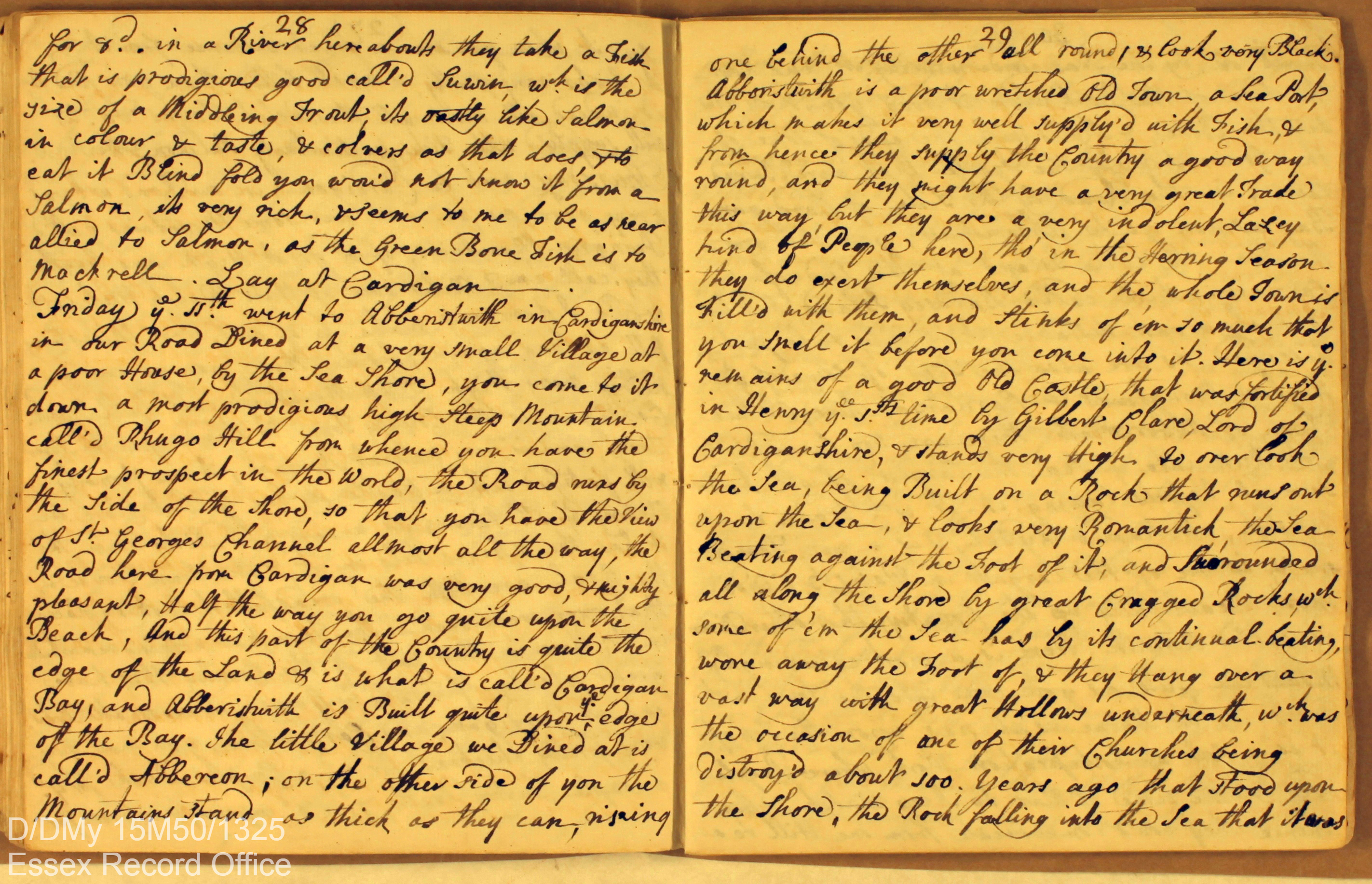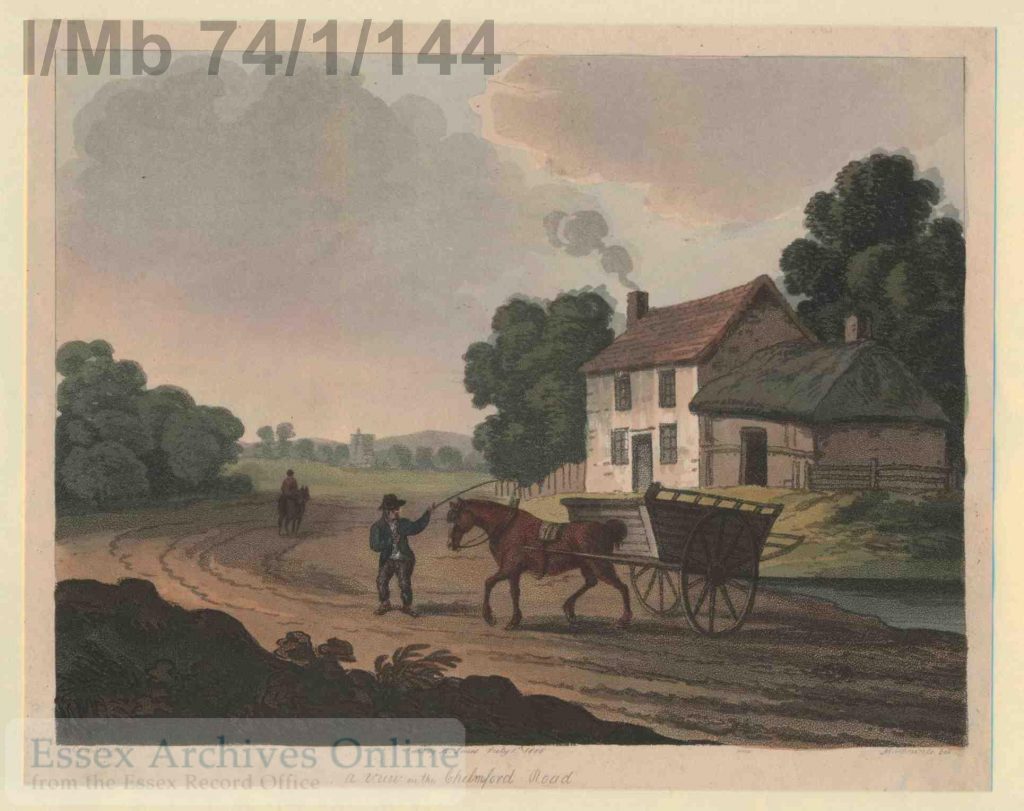Abboristwith is a poor wretched Old Town, a Sea Port which makes it very well supply’d with fish … they might have a very great trade here but they are a very indolent Lazy kind of People here…
These scathing comments about the town of Aberystwyth are taken from a journal of a tour through England and Wales in the 18th century (D/DMy 15M50/1325). Although unimpressed by the town, the author did at least enjoy the view from nearby Rhugo (?) Hill from whence you have the finest prospect in the World … so that you have the View of St. George’s Channel almost all the way.

(D/DMy 15M50/1325)
The diary begins in Oxford and the journey continues through Gloucestershire, Worcestershire and Shropshire before entering into Wales via Hay on Wye. The writer then visits most of the Welsh counties (except for what was then Monmouthshire and Glamorganshire), returning to England via ‘West Chester’ (Chester) and continuing through Lancashire and Yorkshire and then south to Hertfordshire and London. On the way, he inspects castles, cathedrals and great houses ranging from the well-known (Powis Castle and Erddig, both now owned by the National Trust) to ‘Choffden Court’ (Shobdon Court, Herefordshire, now demolished).
The journal makes no reference to Essex, but the author is presumably one of the Mildmay family of Chelmsford, since it came to us with a collection of their family papers. We do not know with whom he travelled or the cost of any of his lodgings or meals – sadly this sort of information simply isn’t recorded.
Only the day and month are recorded; we knew that it took place in late July and ended in late September, but could not be certain of the year. Internet searches (not possible when the document was first deposited) enabled us to narrow down the period when the diary was written.
A reference to the then Bishop of Banger, Dr Herring, meant that we knew the author must have visited sometime between 1737 and 1743. Checking against a perpetual calendar suggested the diary was written in 1741, but further cross-checking in Cheney’s Handbook of Dates indicates it was actually 1738.
The later 18th century saw a growing interest in tourism within Britain, made easier in part by improvements to roads through turnpike trusts and encouraged by an increase in guidebooks. The volume is therefore early evidence of this enthusiasm for travel.

The document is on display in the Curiosity Cabinet in the Searchoom until September.
You can view the Curiosity Cabinet and more on our next public Searchroom tour, on 5 September at 10:30 a.m. This 45-minute tour will show you how to get the very best from the Record Office’s Searchroom and is ideal if you are just starting your research. Find out more and book online.

re the Aberystwyth entry: As a Welshman from those parts and a former student at Aberystwyth, I think students possibly continued the habit described ! In fairness however, the fishermen described were very active in the morning! The Essex visitor was obviously not familiar with the dawn fishing practices of the locals Incidentally, sewin is indeed a prized fish on the welsh rivers teifi and tywi- a good fighter and delicious. We locals would say it eats better than salmon. Best and a lovely work to include John Evans – I will visit to see the original and will tell the Chelmsford & District Welsh Society of it
I’m glad you enjoyed seeing the document. There are a few ex-Aberystwyth students here at the Essex Record Office (myself included) and that was my favourite entry. He also visited Cardigan, Aberaeron and Devil’s Bridge.
You’re welcome to visit while the diary is on display – as are the Chelmsford and District Welsh Society. Or you could wait till October and view the document in its entirety in the Searchroom once it is out of the display case.
I saw the original diary several years ago. I think it dates to 1738, not 1741. The writer records that Ripponden church washed away 15 years before by a violent flood [this occurred in 1722] giving the date of the diary about 1737. However, the dates and days in the diary place it as 1738 (in the example page you show, he gives the 11th [August] as a Friday which is correct for 1738, but not 1741).
On the road from Cardigan to Aberystwyth he writes ‘Half the way you go quite upon the Beach’.This is probably the road from Llanon towards Llanrhystud, 4 miles from Aberaeron, 12 miles from Aberystwyth which used to run to the west of the church but was washed away by the sea at some time presumably in the 18th century. The reference to the bones and skulls confirms that the original churchyard of St Mary was washed away by the sea.
This is one of the earliest tours of Wales and parts of England for pleasure.